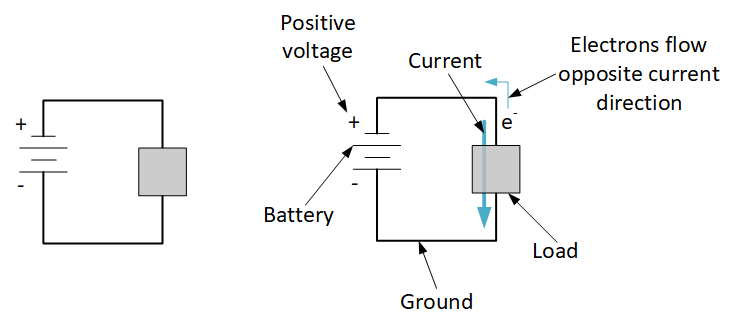
[From the last episode: We looked at high-level notions about energy and powerThe rate of energy consumption. For electricity, it’s measured in watts (W). – and the difference between the two.]
We looked a few months ago at basic electrical ideas: voltageVoltage is what gets electrons to flow. It's analogous to water pressure, which gets water to flow. Voltage is measured in units of "volts.", currentThe amount of electrical flow. Measured in amperes or amps (A)., resistanceForces that tend to reduce the amount of flow or current. Measured in ohms (Ω)., and power. And we used a popular analogy with the flow of water to help make the ideas clearer.
But, of course, we know that there’s no water involved. Is that just a convenient analogy, or is there more to it?
Where Electrons Flow…
There’s actually more to it. Just as our pipes carry water, the wires carry electronsA fundamental particle found outside atoms. It carries a negative charge. It can move easily in a conducting material, which gives rise to electrical current.. It’s the flow of electrons that makes current. Those electrons flow under the “pressure” of a voltage. And the flow is resisted by “resistance” – of the electrical sort.
We tend to say that the flowing electrons do work. In fact, they may do nothing useful – many electrons are wasted. Or sometimes it takes more electrons to do some work than it needs to. It’s an ongoing design goal to do more work with fewer electrons.
There are some superficial differences with water, of course. The most obvious one is that, when you turn water on through, say, a hose, it takes a while for the water to get to the end of the hose. And yet, when you turn on a light switch, the light turns on immediately – there’s no waiting.
That’s because, when you turn the water off, the hose empties out. When you turn the water on again, the hose has to fill up first before it starts flowing out the end. There’s no “leaking” of electrons out of the wire on that kind of scale. In other words, when you shut the electricity off, the electrons simply stop and remain in place. They don’t dribble out of the wire.
So when you turn the electricity back on, there are electrons waiting right there in the wire, and they immediately start doing work. (Technically, there are extremely short delays, and leakageThe very small amount of current that can flow through a transistor when it's "off." can be a thing, but it’s not on the same scale as what we see with water. We’ll talk more about leakage later.)
Circuits and How We Label Them
Before we get more into this, there are some conventionsAn agreement on some decision that could be made several ways. For example, given a single bit, you could decide that 1 means "true" and 0 means "false," or you could decide the opposite. Similar in spirit to a protocol, but protocols usually deal with how something is done -- a step-by-step process, for example. we need to talk about. It’s not completely intuitive in all ways. On the other hand, if you stick to these conventions, everything is consistent and works, which is why we have the conventions.
Electrons have a negative charge. Because opposites attract and likes repel, that means that a positive charge will attract a negative charge. By applying a positive voltage, it’s like the battery is setting up this promise of positive charges that draws the electrons in. That’s what gets them flowing.
The drawing below shows a really simple circuit. (I’ve shown it twice, once so that you can see how simple it is, and then with labels). On the left of the circuit is a battery, and you can see that it is adorned with a + and a – , just like household batteries. The + side means that’s the positive side – the side that will attract electrons. The chemistry of the battery establishes what the voltage will be, and, as the battery is used up, the voltage will drop over time.

On the right, we see what’s called a load. I show it as just a box, but it could be a lightbulb, for example. It’s something that the current flows through, and as it does so, the voltage drops. It’s almost as if the work being done is “using up” the voltage.
How We Get Current
That load has some resistance, and that resistance determines how much current flows. Intuitively, if there’s little resistance, then you’ll get lots of current; if the resistance is high, you’ll get less. If you literally make that load a wire (almost zero resistance), then we would say that you’re shorting out the battery, and you get a really high current that can cause trouble if not controlled.
Finally, here’s the thing that’s annoying if you think about it too much. By convention, we say that current flows from the positive side around through the load to the negative side. That negative side is sometimes referred to as ground or common. But here’s the thing: we know that electrons flow towards the positive.
That means that, even though the direction of the current is shown as flowing down through the load, the electrons are actually moving up through the load. Yup, even though current means flow, the direction of current is actually the opposite of the direction that the electrons are flowing. Kind of a head-scratcher. But it all works, so best not to think about it too much once we’ve convinced ourselves that it works.
From Ohm’s Law, we saw that:
![]()
where V is voltage, I is current (don’t ask me why*), and R is resistance. We can shuffle this around to give:

In other words, if we have 9 volts and the resistance is 3 ohms, then the current will be 3 amps. Intuitively, you can see from here that, if resistance goes up, then current goes down, because we’re dividing by resistance.
How We Use Energy
We also saw that power is
![]()
So, using those same numbers, the power would be 9 volts times 3 amps, or 27 watts.
Finally, we saw last week that energy is
![]()
where P is power and t is the time you run the circuit. In other words, if you run the circuit for, say, 10 seconds, then you used 27 watts times 10 seconds, or 270 joules.
Yeah, it’s math, but it’s easy math. And it shows you how we get from a circuit to energy consumption.
By the way, notice that everything flows in a circle. The current leaves the battery from the top, goes through the load, and comes back to the battery at the bottom. This is critical – and it’s why it’s called a circuit. If you break the circuit, then there is no flow. That’s what a switch does.
*OK, I had to know. Turns out, according to Wikipedia, that “I” comes from the French “intensité du courant,” or “intensity of current.” Who knew!

Leave a Reply